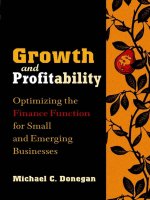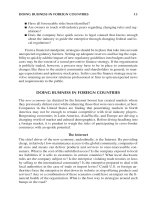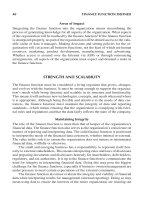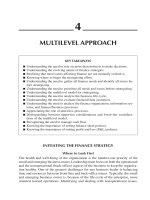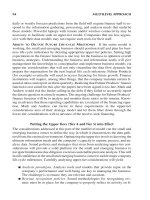GROWTH AND PROFITABILITYOptimizing the Finance Function for Small and Emerging Businesses phần 1 potx
Bạn đang xem bản rút gọn của tài liệu. Xem và tải ngay bản đầy đủ của tài liệu tại đây (303.9 KB, 27 trang )
GROWTH AND
PROFITABILITY
Optimizing the Finance Function
for Small and Emerging Businesses
To a loving family
(Mom, Dad, Pam, Lorraine, and Christine)
and a God that is love
GROWTH AND
PROFITABILITY
Optimizing the Finance Function
for Small and Emerging Businesses
Michael C. Donegan
John Wiley & Sons, Inc.
This book is printed on acid-free paper.
Copyright © 2002 by John Wiley and Sons, Inc. All rights reserved.
Published by John Wiley & Sons, Inc., Hoboken, New Jersey.
Published simultaneously in Canada.
No part of this publication may be reproduced, stored in a retrieval system or
transmitted in any form or by any means, electronic, mechanical, photocopying,
recording, scanning or otherwise, except as permitted under Sections 107 or 108
of the 1976 United States Copyright Act, without either the prior written permis-
sion of the Publisher, or authorization through payment of the appropriate per-copy
fee to the Copyright Clearance Center, 222 Rosewood Drive, Danvers, MA 01923,
(978) 750-8400, fax (978) 750-4470. Requests to the Publisher for permission should
be addressed to the Permissions Department, John Wiley & Sons, Inc., 111 River Street,
Hoboken, NJ 07030, (201) 748-6011, fax (201) 748-6008, e-mail: permcoordinator@
wiley.com.
This publication is designed to provide accurate and authoritative information in
regard to the subject matter covered. It is sold with the understanding that the pub-
lisher is not engaged in rendering legal, accounting, or other professional services.
If legal advice or other expert assistance is required, the services of a competent
professional person should be sought.
Wiley also publishes its books in a variety of electronic formats. Some content that
appears in print may not be available in electronic books.
Library of Congress Cataloging-in-Publication Data
Donegan, Michael C.
Growth and profitability : optimizing the finance function for small
and emerging businesses / Michael C. Donegan.
p. cm.
ISBN 0-471-21216-4 (CLOTH : alk. paper)
1. Small business—Finance. 2. Financial statements. I. Title.
HG4027.7 .D66 2002
658.1—dc21 2002001893
Printed in the United States of America.
10 9 8 7 6 5 4 3 2 1
FOREWORD
Liquidity. No company can successfully operate without it. Access to cash, when
it’s needed, becomes so important that all other considerations are secondary. The
recent bankruptcies of industry giants Enron and Kmart and the severe liquidity
struggles at Lucent Technologies are sobering reminders of the need to maintain
healthy cash flow at all times. One might ask: if the “sophisticated” giants can fall
on their collective faces, then what hope does the small or emerging business
owner have?
The answer lies in having a solid plan. Actually, the plan is less important than
the act of continuously planning. The road to business success is full of unexpected
twists and turns, and ongoing planning allows for the necessary adjustments that
make the journey worthwhile. Additionally, planning by its very nature commits
the owner/executive to the visualization and preparation needed for the future—a
necessity when put in a financial context.
But how should companies do it? This book lays the foundation for a solid
start. As Michael Donegan deftly points out, no entrepreneur starts with a finance
function, or a plan for strategically building that function. Yet, every transaction in
which the entrepreneur engages is ultimately measured by dollars and cents with
the medium of measure born from the finance function—data. Ignoring or mini-
mizing this function is certain to lead to trouble.
Although most owner/executives have an exclusive sales and operations fo-
cus, sooner or later an appreciation for the strategic necessity of the finance func-
tion is recognized as a key ingredient to success. Missing revenue or profitability
targets can happen multiple times but companies will only run out of cash once.
Don’t let it happen to your business.
Thomas F. Donahue
Corporate Finance Consultant
Former Corporate Treasurer—Sensormatic Electronics
Corporation and Citibank Universal Card Services Corp.
July, 2002
ACKNOWLEDGMENTS
Because writing a book is no easy task, I am truly indebted to Heidi Oneacre for
her diligence and persistence in editing this work. Her ability to deliver criticism
balanced with careful measures of sensitivity and encouragement was invaluable
and greatly appreciated. Additionally, I would like to thank Tim Oneacre for his
hospitality and keen insight into the English language.
Special thanks go to Chris Muccio, with whom much of the material for this
book was developed. I would also like to thank Mike Fredericks for being a wor-
thy partner in the trenches and a continuing source of technical knowledge rivaled
by none. A thank-you goes out to Jean Nelson for giving me the opportunity to ex-
cel. Finally, I’d like to thank Michael Sincere for providing direction when it was
most needed.
PREFACE
Information is the life-blood of decision making. While companies are willing to
dedicate resources to advertising, marketing, and sales initiatives, they are often-
times reluctant to devote the same to garnering accurate and timely financial in-
formation to make business decisions. Very few executives and business owners
will deny the value of building and maintaining reliable mechanisms for handling
the financial data needs of the organization. However, actions often fall short of
this intention. It is not unusual to see the proliferation of annotated information
systems and inadequate processes throughout the business community. Whether it
is the potentially ambiguous value proposition or the sheer complexity involved
with creating a reliable finance function, many organizations unintentionally dis-
count the need for a strong one or, worse, relegate it to the status of a necessary
evil. Understanding why this happens is second only to recognizing the telltale
signs that it is happening in the first place. Can the organization translate its busi-
ness to financial statements quickly and accurately? Can the reporting process rap-
idly reflect changes in the business organization? A more overt hint may come in
the unwillingness to dedicate budget dollars to the finance area on an ongoing ba-
sis. While marketing, sales, or other key operations people can dictate major poli-
cies and resource commitments, can the finance area do the same? Companies, es-
pecially in their early years, will live and die with the success of marketing and
sales efforts. However, their capacity to translate financial data from the business
environment into knowledge will either bolster marketing and sales efforts or
negate them altogether. Ensuring the long-term stability of information flow and
the decision support system requires alignment of priorities in thought and action.
I have witnessed many times this juxtaposition in thought and actions. The
minimization of the accounting and finance aspect of the business is rarely inten-
tional, but rather a function of ignorance, misinformation, or misguided business
culture. Many executives and business owners are simply not equipped with an ad-
equate perspective of the finance function or the value it provides. Additionally,
they may not be committed to cultivating this aspect of their business. Executives
reared on the operations side often are led to believe that this area is overhead and
must be strictly controlled from a fiscal standpoint. The extreme return on invest-
ment (ROI) business culture that prevails has fueled this misconception. Having
spoken on the topic of strategizing the finance function to large and small groups,
I receive all sorts of feedback, most of which deals with the fact that there simply
is not a definitive base of knowledge that addresses the finance function in its en-
tirety. Many finance and nonfinance people want to address this aspect of their
business but find very little accessible guidance. Because easy-to-understand lit-
erature is lacking, many companies resort to engaging high-priced consultants
and/or hiring expensive finance executives to develop comprehensive finance
strategies. Much of the dialog I have with finance professionals comes about as a
result of a marked breakdown in the finance area that is manifesting itself in some
harmful way. Comments are often preceded by “Had I known . . .” or “If someone
had only told me.” Throughout my career, I have designed, implemented, and
maintained finance applications on a global scale and discovered firsthand the
staggering lack of accessible knowledge on the overall topic of defining the fi-
nance function. The frustration I experienced in following through with my objec-
tives in this realm was the chief motivator for this book.
This book was almost titled Guerrilla Accounting, the premise being that it
does not take considerable depth and breadth of knowledge to lay the groundwork
for a sophisticated finance function. The objective of this text is to address the gen-
eral lack of knowledge and misinformation related to the finance area while creat-
ing the mind-set to establish a finance-friendly culture. Although no reader will
come away with all the answers to all the issues related to the finance function, it
is my hope that many will achieve that first breakthrough—realizing the need for
a finance function. The small and emerging business owner must recognize the
need for developing a culture in business that values a solid finance/accounting
function. A culture of awareness will breed the development of good fundamentals
related to a strong data flow dynamic. The danger is waiting until the need for one
is great. Much like runners who reach for the water bottle when thirst is already
upon them, waiting until a critical juncture in the business’s life cycle to begin de-
veloping a solid finance/accounting organization may be too late. Laying the
groundwork early and developing sound fundamentals and awareness is much like
hydrating oneself before a race. The challenge is overcoming the subtle and some-
times long-term ROIs. Although ROIs are critical, establishing a mind-set of
growth and progressivity in the finance area will preempt the awkward recurring
rationalization of expenditures for seemingly unproven and expensive finance
projects.
My intention in pulling these thoughts together is to provide readers a defini-
tive starting point in dealing with this often confusing and complex area of their
business. The central focus of the book is the methodology for gathering all the
considerations that factor into developing the finance/accounting area of a busi-
ness. Because certain considerations are more fundamental to overall finance func-
tion development than others, these areas of focus are arranged in a pyramidlike
structure with the more fundamental business considerations appearing at the bot-
tom of the pyramid and the more finance specific considerations arranged at the
viii PREFACE
top. The small and emerging business owner, who may be short on time, money,
and know-how, can benefit greatly from referencing this model. It will provide a
knowledge base from which a relevant finance function can be developed and
maintained. The model itself is universal and applies to all businesses, large and
small, and can be utilized by business executives/owners regardless of their knowl-
edge level in the finance/accounting area. The essence of this multilevel approach
to strategizing the finance function is to provide insight on what needs to be done
and when. The model itself provides guidance in the initial setup and design of a
finance function as well as its evolution and adaptation as the business grows. The
considerations arranged in this pyramid form will allow the owner/executive to
make well-informed, relevant decisions related to employing systems technology,
designing processes, hiring professionals, and developing financial analysis tools.
The small and emerging business owner will face many challenges in the early
years of the business. This focus on the living, breathing data-flow dynamic will
preclude unnecessary attention on accounting issues related to properly employing
generally accepted accounting principles (GAAP). This book concentrates on de-
veloping concepts, imparting knowledge, and developing actionable strategies.
The object is to convey and develop a perspective and approach to addressing
overall developmental finance and accounting matters and spur action as it relates
to developing a suitable finance function. Developing a methodology for ap-
proaching this area as opposed to defining particular solutions will serve the small
and emerging business owner well as the business evolves and data needs change.
The best way to use this book is to identify and make note of similarities be-
tween your business circumstances and those highlighted in the examples dis-
cussed. Recognizing circumstances that prevail with your business peers and/or
competition is also recommended. Understanding what is being done wrong is as
important as recognizing what is being done right. Then use this as a reference in
troubleshooting or anticipating issues that may put your organization at a disad-
vantage. Particular areas of reference will be the chapters dealing with the multi-
level approach (Chapter 4), processes (Chapter 6), information systems (Chapter
7), and writing the strategy document (Chapter 9). There are no right answers or
premier solutions for the informational needs of a business; however, developing
the discipline to corral the issues and questions that must be addressed is impera-
tive. Developing and maintaining a sound finance function is an iterative process
and will take time and patience. While trial and error may be a necessary compo-
nent of development, this book will help clarify what needs to be done and when.
Be patient and open-minded as your finance function evolves. Change is unavoid-
able; in fact, it will be critical in the finance area if the finance function is to re-
main relevant and value-added for the organization.
The key to success in this area is an open mind and a willingness to embrace
new and innovative ideas in systems and process design. We are living in exciting
PREFACE ix
times where technology is developing at what seems to be warp speed. Achieving
success will mean matching up well-defined needs with carefully crafted solutions.
More important, success in this area will be manifested by a thriving business.
Evolving data needs will mean the business is growing. It is critical that an aware-
ness of the finance function be maintained as the business matures. I wish you well
in developing your new business or growing your existing one.
x PREFACE
CONTENTS
Chapter 1 DOING BUSINESS IN TODAY’S
ENVIRONMENT 1
Objective 1
What Is the Perception of Finance and Accounting? 2
Defining Small and Emerging Businesses 4
Why Is the Business Owner in Business? 5
Data Needs 6
Going from Day to Day to Long-term Strategy 6
Dealing with the Business Environment 8
Going Public 9
Regulatory Requirements 12
Doing Business in Foreign Countries 13
Litigation 15
Technology Needs of Vendors and Customers 16
Employee Needs 17
Strikes 17
Natural Disasters 18
Ten Questions 18
Final Thoughts 21
Chapter 2 FINANCE FUNCTION DEFINED 23
Finance Function in Action 23
Defining the Finance Function 28
Component Parts 29
Traditional Perception of the Finance Function 32
Need for Integration into Operations 35
Strength and Scalability 40
Final Thoughts 43
Chapter 3 WHY STRATEGIZE? 45
Strategizing in All the Right Places 45
Benefits of Strategizing 49
Initiatives Shaping the Finance Organization 53
Scope of Strategizing 55
When Does Strategizing Begin to Count? 58
Key Dependencies 58
Initiating the Culture of Strategy 60
The Future: Ready or Not, Here It Comes 63
Final Thoughts 66
Chapter 4 MULTILEVEL APPROACH 67
Initiating the Finance Strategy 67
Assessing Needs 70
Tier 1 Considerations: Life Cycle 74
Tier 2 Considerations: Data Customers 79
Tier 3 Considerations: Infrastructure 82
Upper-Tier Considerations 91
Tier 4 Considerations: Optimizing the Balance Sheet 95
Tier 5 Considerations: Optimizing Profit and Loss 98
Final Thoughts 103
Chapter 5 ANALYZING DATA CUSTOMERS 105
Why Analyze Data Customers? 105
Defining Data Customers 110
Evaluating Data Customers 117
Anticipating Data Customer Needs 122
Linking Data Customer Needs to Finance Strategy 124
Final Thoughts 127
Chapter 6 DATA FLOW PROCESS 129
Role of Processes 129
Data Flow Ecosystem 135
Evaluating Current Processes and
Conceptualizing Future Processes 142
Integrating Data Flow Process with the Business 147
Development with the Rest of Infrastructure 157
Final Thoughts 160
Chapter 7 INVESTIGATING
INFORMATION SYSTEMS 163
Information Systems Considerations
in the Multilevel Approach 163
xii CONTENTS
Maintaining the High-Level Vision for Strategizing 167
Initial Considerations 171
Planning 175
Implementing Systems 183
Up and Running: Maintenance 187
Final Thoughts 189
Chapter 8 FINANCIAL REPORTING 191
Understanding the Need to Report Financial Data 191
Employing Accounting Methodologies to Serve Current
and Future Needs 199
Creating Models for Internal Analysis
and Measurement 204
Issues in Creating Financial Statements 207
Maintaining Good Reporting 211
Final Thoughts 214
Chapter 9 WRITING THE STRATEGY DOCUMENT 215
Purpose of Defining/Documenting
the Finance Strategy 215
Preparing to Write the Document 219
Composing the Strategy Document 224
Putting the Document to Use 231
Evaluating Performance 233
Enabling Future Development 235
Final Thoughts 237
Appendix FINANCE STRATEGY: DOWNEY INTERIORS 239
Index 253
CONTENTS xiii
1
DOING BUSINESS IN TODAY’S
ENVIRONMENT
OBJECTIVE
The objective of this book is to cut to the core purpose of the finance function and
create a context for laying the groundwork for a sound finance organization. Un-
like traditional accounting and finance guides, this book does not address the
esoteric (and complex) pronouncements issued by the accounting industry for in-
terpreting transactions and events. Instead, it provides the conceptual framework
for the small business owner to lay a sound foundation of finance infrastructure
now that can be built on successfully in the future. In so doing, this book also ad-
dresses the necessary relationship between finance objectives and operational
goals/initiatives of the enterprise. Additionally, the data flow dynamic is addressed
as well as how it impacts the objectives of the business as a whole. Putting finance
and accounting in the context of the “entire” business helps the small and emerg-
ing business owner create not only a sound finance function but also a culture of
KEY TAKEAWAYS
■ Understanding the objectives of this book.
■ Understanding common misconceptions regarding the finance function.
■ Defining small and emerging businesses.
■ Understanding the role data management plays in the enterprise.
■ Understanding the core motivation for staying in business as well as the busi-
ness owner’s roles/responsibilities as leader of the organization.
■ Understanding the need for data analysis.
■ Understanding how the dynamic of converting data to knowledge impacts the
capacity to be long-term vision oriented.
■ Understanding that the changing business environment will impact operations
as well as business strategies.
■ Becoming familiar with eight high-risk business circumstances.
decision making and analysis that will enable the organization to devote more en-
ergy to making long-term strategic and day-to-day decisions that add value to the
overall business.
Why focus on small and emerging business owners/executives? Perhaps the
reason lies in the corporate mortality rate. Of the 800,000 to 900,000 businesses
formed each year in the United States,
1
over 80% will close their doors within five
years of inception. It is interesting to note that nearly 50% of these failures are
due to management’s lack of managerial and fiscal savvy. An additional 16% of
these failures are due to the improper balance of operational and financial initia-
tives. There are many reasons for business failures, although it is clear that many
are due to the inability of owners and executives to balance administrative and
back-office functions like finance with operations. By tying the finance function
to operations, small and emerging businesses that are inherently at risk can (at
best) buoy themselves into profitability or (at the least) extend their lives through
challenging times.
WHAT IS THE PERCEPTION OF FINANCE AND ACCOUNTING?
Small business owners and executives are compelled to wear many hats in carry-
ing out their duties as leaders of a business organization. Often the accounting/
finance hat is the one most avoided. The small and emerging company’s survival
depends largely on the health of the finance function. Knowing this, any trepida-
tion about handling issues that affect the finance/accounting function must be
overcome before a tendency to avoid finance issues becomes a culture of neglect.
Reluctance to address the finance function properly often stems from misconcep-
tions and half-truths—these are dangerous because, left unchecked, they eventu-
ally will lead to bad decisions. Common misconceptions toward the finance
function borne by small and emerging business owners are often expressed in one
(or more) of five ways:
1. Accounting and reporting are administrative/back-office functions not
considered the front lines, so who cares? The reality is the accounting/
finance function underscores virtually all aspects of the front lines of any
business enterprise, whether it dictates the language of sales contracts, de-
fines customer payment terms, or helps determine sales quotas. Unlike
most areas of a small and emerging business, finance decisions may not
yield that rush of instant gratification or obvious benefit. In fact, the return
on investment (ROI) on a finance plan or investment in infrastructure may
2 DOING BUSINESS IN TODAY’S ENVIRONMENT
be long term and/or extraordinarily subtle. This notwithstanding, the fi-
nance function is no less important as a primary driver for the organization.
2. Between consultants, applications, and hardware, the accounting func-
tion is a money pit. This is often the case with poorly thought out infra-
structures or myopic strategies—a symptom of many emerging companies
in swiftly moving industries. Decision making as it relates to information
systems and applications must have a mid- to long-term focus. The speed
at which software and hardware becomes obsolete forces organizations to
face the same purchase decisions over and over again. When it comes to
accounting and finance software packages and the technological plat-
forms that drive them, user needs must play an equal or greater role in the
purchase decision process.
3. Accounting and finance issues are simply too complex to deal with. Rather
than dealing with them incorrectly, I’ll just ignore them. These issues al-
most never become barriers to the business when they are identified and
dealt with early on. Understanding the business itself and having a solid
idea of the strategic direction go a long way toward addressing account-
ing and finance issues, whether they are changes in accounting/disclosure
rules, infrastructure issues, or data availability issues. Knowledge of the
business, the industry in which it operates, and the status of industry peers
give the business owner the opportunity to at least recognize when a ques-
tionable finance issue is encountered. Sometimes it is just as important to
know when to ask a question as how to answer it.
4. As long as I have customers and revenues, the accounting will take care of
itself. Customer generation and retention may be the direct result of how
well the company costs and bills customer jobs—a major part of the ac-
counting and finance area. In this and other ways, the finance function dic-
tates how effectively the organization approaches prospective customers and
handles existing ones. Skill at budgeting and forecasting will drive positive
relationships with suppliers, and the ability to close the books company-wide
will drive positive relationships with owners, shareholders, and analysts.
5. I simply do not have time to deal with the accounting function. I have to
get revenues now or I am finished anyway. The fact is, everybody is
busy. The business owner can deal with the accounting and finance func-
tion now or wait until a problem arises as a result of neglect and put the
fire out then. Short-term thinking is a slippery slope where many execu-
tives lose footing, especially if the company is publicly traded and has
quarterly earnings expectations. Many executives and business owners
see shortsighted decisions as the better alternative to neglect. This may be
so; however, engaging in short-term decision making may be ultimately
as damaging to the organization.
WHAT IS THE PERCEPTION OF FINANCE AND ACCOUNTING? 3
DEFINING SMALL AND EMERGING BUSINESSES
How are small and emerging businesses defined? It is difficult to suggest parame-
ters that categorize businesses as small, emerging, or growth companies. The pur-
pose of this book is to educate the business owner in how to deal successfully with
circumstances that will be encountered as the company matures. With this in mind,
definitions for small and emerging businesses will be suggested, knowing that each
and every business has its own set of circumstances and challenges, regardless of
its size or stage of development. The intent is to create a context to examine finance
and accounting-related issues from the point of view of a developmental stage
business. The idea is to capture the circumstances of the business owner/entrepre-
neur who is not well versed in the intricacies of finance and accounting and to pres-
ent solutions to existing issues while preventing future difficulties. The following
sections define small and emerging businesses.
Small Businesses
Businesses are defined and categorized based on any of a series of classifications:
revenues, assets, number of employees, office/lease space, and so on. This text
loosely follows the definition of small business used by the Small Business Ad-
ministration (SBA):
■ Revenue. Companies with revenues less than $100 million
■ Number of employees. Companies with 500 or less employees
2
■ Value. Companies with a net worth less than $18 million
3
A few categories of small businesses may be worth mentioning:
■ Mom & Pops. This term is uniquely descriptive of a piece of Americana
which connotes a single-site operation that serves more as a lifestyle en-
deavor to owners than a revenue-generating cash machine. A Mom & Pop is
typically a mature, stable organization with little or no momentum or incli-
nation to change. It usually does not have a succession plan if the owners
leave or become unable to run the business.
■ Family owned. These business types serve mostly to enrich the lifestyle and
culture base for owners and their immediate family. The implied succession
of the business to future generations assures a reasonable amount of forward
momentum of the enterprise. It may be a single-site operation or be operat-
ing in multiple geographic and functional areas.
■ Start-up. Start-ups, which are described in more detail under “Emerging
Businesses”, may have small or large revenue streams. The term refers to
businesses with less than $100 million in revenues, less than 500 employ-
4 DOING BUSINESS IN TODAY’S ENVIRONMENT
ees, and/or less than $18 million in equity (net worth). They may be public,
private, or family owned.
■ Net ventures. Though net ventures have lost some of their luster of late, this ubiq-
uitous business form deserves attention. This term refers to companies whose
business model is driven almost exclusively by the Internet. Business-to-
Business, Web solutions, Dotcom, and E-Commerce are a few of the terms that
personify net ventures. It is worth mentioning this business type since so many
high-profile net ventures have spanned the entire business life cycle in recent
years. This category has been deemed the new predominant cottage industry
due, in part, to the lack of entry barriers in taking an idea to a business form.
Emerging Businesses
An early-stage or emerging business is also referred to as a start-up. For purposes
of this book, companies less than five years old are considered emerging businesses.
These businesses often balance new products and technology with burgeoning mar-
kets. Typical of emerging businesses is the need for infrastructure—buildings,
technology, business processes, and the people to manage them. Perhaps the most
significant characteristic of emerging businesses is their likelihood of being
headed by “green” leaders who may be long on hope and enthusiasm but short on
experience. Emerging businesses may be public or private, large or small.
WHY IS THE BUSINESS OWNER IN BUSINESS?
Starting a business can be an exciting and rewarding undertaking. It also can be
scary and, at times, overwhelming. Regardless of how one gets started or why,
owners of a small or emerging business will find that their new life’s purpose will
be presiding over matters of operations and administration. As they drive the com-
pany forward, the intention is to strengthen the company, in turn increasing their
own wealth or the wealth of absentee owners.
From a textbook perspective, the purpose of the corporation is to maximize
shareholder wealth. In recent years the business culture has translated this into cre-
ating value for shareholders or owners. Regardless of how the motives for going
into business are defined, most entrepreneurs do so with the intention of making
their lives better. This objective may be achieved through a perpetual, steady up-
ward trend or (as is the case with more mature, public companies) through a syn-
ergistic event such as a merger, an acquisition, or a necessary divestiture.
Owners of small and emerging businesses have the daily responsibility of fo-
cusing on the most fundamental matters of business. The pressure of applying seed
money wisely and effectively in a lightning-quick business environment is a big
enough challenge without having to learn the finer points of being an administrator,
WHY IS THE BUSINESS OWNER IN BUSINESS? 5
delegator, and firefighter. As the company matures, stabilization and making order
out of chaos will be followed by the need to create structure that will endure. The
business owner or chief executive’s role is to build a sound management team as
well as conserve and safeguard available resources. These objectives will be fol-
lowed by the need to build a sound business strategy and put it in motion.
DATA NEEDS
Being the chief visionary in a small/emerging business means dealing with the daily
struggle by subordinates and customers for time and attention. In spite of these demands,
one objective always must remain at the fore: turning a profit and turning it quickly. For
many small and emerging business owners, the formative years of the business are heav-
ily dependent on getting results now. Time to develop markets, products, and a recog-
nizable brand is often in short supply. The pressure to not only make decisions but to
make good decisions seems overwhelming at times. To avoid guessing and/or consult-
ing the crystal ball for answers, the small/emerging business owner will need to make
sense out of the environment in which the company operates. Successfully managing
data is the key to making sound decisions. Later chapters discuss the foundation of pro-
viding for data needs including data collection, analysis, and translation to knowledge.
As the data flow dynamic is explored, it is important to focus on the ultimate
objective of data management, which is generating knowledge. It is through
knowledge that solid decisions are made and strategies are built. Knowledge de-
pends on data analysis; data analysis depends on data processing; and data pro-
cessing depends on data gathering. The need to engage in all of these activities in
a timely manner underscores the whole effort.
The most important use of knowledge is to develop and employ performance
measures also referred to as metrics. Developing performance measures, whether
they are revenue targets, expense ratios, or return on investment (ROI), will depend
on the business owner’s reliance on knowledge of the business and the environ-
ment in which it operates. It is not surprising that almost 35% of U.S. businesses
(large and small) fail to create real value because they apply incorrect performance
measures.
4
The superior organization will have not only a sound data flow dy-
namic but also the know-how to interpret or analyze the knowledge derived from
the data it generates. Establishing a culture of analysis in the infant years of the or-
ganization will pay dividends as the company grows.
GOING FROM DAY TO DAY TO LONG-TERM STRATEGY
Understanding that business owner/executives need data to analyze and need it
quickly is not enough to satisfy their decision-making requirements. They must de-
termine the what, when, and how relative to creating the infrastructure and culture
6 DOING BUSINESS IN TODAY’S ENVIRONMENT
that will yield this capability. It is important to recognize that creating a finance
function that serves the organization’s needs is not easy and does not happen
overnight. The ROIs are often mid to long term and subtle in nature—characteris-
tics that may impede investment in this area for many small organizations.
Leaders of organizations often are overburdened and preoccupied with “right-
now” issues. Although yielding revenue and cash in the short term is a necessity
for small and emerging enterprises, it is imperative that some attention be diverted
toward matters of data quality, flow, and timing—issues requiring long-term focus.
The temptation is to think short term. The challenge, however, is to see into a
longer time horizon when it comes to developing the finance function. Unfortu-
nately, the reality is that because many companies make decisions to get them
through the short term, they inadvertently derail the likelihood for mid- to long-
term prosperity. This is especially true when it comes to investing in infrastructure.
Consider this example:
Ira is an executive of a company that manufactures electronic components.
Like thousands of other executives, he is struggling to come to terms with a
series of decisions he has made regarding his company’s information systems.
About 15 months ago Ira gave the nod to an investment in an accounting soft-
ware application and an accompanying server upgrade. The need, as he un-
derstood it, centered on pressure to enhance the accounting consolidation
function (the gathering and processing of company-wide financial data). The
push was to get something in place within a three-month window—in time for
the year-end close. The application in question came highly recommended by
his Information Systems (IS) department and was reputed to work best on this
particular server. Although it could operate on a larger one, Ira opted for what
he thought was a prudent decision not to spend any more money than neces-
sary to provide the platform to run the application. He ultimately OK’d over
$100,000 for this project. He was assured that he was getting off cheap, given
the array of other server options that would also work. He was convinced his
decision was fiscally prudent and made sense for his finance department,
though they did not actually drive the decision. The project yielded mediocre
results for the year-end close—as they experienced the usual snafus related to
meeting deadlines, training, and so on. The fallout, however, came six months
later when the company went forward with the acquisitions it had been plan-
ning since the prior year. The application was not scalable (it was difficult to
expand upon) and the server environment was woefully inadequate for the
company’s expanded data needs related to the acquisitions. The consensus in
the organization was that Ira wasted $100,000. Ira made the following mis-
takes common to many businesses:
■ His IS department drove the evaluation and selection of an application
used by his finance department, without understanding finance’s re-
quirements.
GOING FROM DAY TO DAY TO LONG-TERM STRATEGY 7
■ The company’s needs beyond the year-end close were not considered,
particularly the future needs of the finance department.
■ The package did not interface well with any of the company’s other
data management applications.
■ Ira sank another $100,000 into a system recommended by his IS or-
ganization subsequent to the deemed failure.
This is a good example of how pressure to solve issues now can yield solutions
that are inadequate in the mid and long term. In this case, Ira’s $200,000 will no
doubt yield another investment equal to or in excess of the original investment.
Like thousands of executives discover everyday, this project will prove to be the
gift that keeps giving (or taking). Would a larger investment on the first go-round
have accommodated the company’s needs over a greater time horizon? Would Ira
have been better served if his finance department had been included in the pur-
chase process along with the IS department? Should the purchase decision been
part of a larger plan to enhance the finance organization? After going through such
an experience, executives are more often in need of salve for their pride than hard
advice on how to not perpetuate the situation. Unfortunately, many executives in
small, mid-size, and large organizations react to short-term circumstances and
make decisions that create more long-term problems than they solve.
Public companies face the temptation to be shortsighted on matters of process
and infrastructure more often than private companies. If the motivation to improve
the closing process and systems fades as the auditors sign off on another quarter,
be warned. The quarters will not get any easier to close, and the data quality will
not get any better if left alone. If a period close or data request paralyzes an or-
ganization, the first step in improving is a commitment to long-term initiatives that
will improve the finance function.
The implosion of the Internet industry (and resulting impact on the stock mar-
ket) shows the pitfalls of rationalizing short-term thinking. In the late 1990s the
prevailing strategy of seeking brand over revenue and cash flow provided a recipe
for disaster. Short-term strategies related to branding were easier and more grati-
fying to pursue from quarter to quarter than were the more heady strategies related
to sustained revenue growth and profitability. The end result in this case is docu-
mented all too well. Using the downfall of many Internet companies as a metaphor
for a mind-set that must be kept in check can be a fulcrum to transform views from
that of day-to-day survival to that of long-term strategic vision.
DEALING WITH THE BUSINESS ENVIRONMENT
Conceiving and building a sound finance strategy involves working with the
known and dealing with the unknown. Creating logical strategic initiatives in a sta-
ble business environment is a challenge in and of itself. The small and emerging
8 DOING BUSINESS IN TODAY’S ENVIRONMENT
business owner, however, must be prepared to strategize in the midst of a chang-
ing world. The shifting business environment always presents situations that
threaten the organization’s objectives. It is the job of the business owner to ensure
that the finance strategy is prepared to deal with inherent threats and turn them into
opportunities.
Any seasoned executive or business owner will agree that avoiding problems
is better than dealing with them as they arise. This is the essence of strategic plan-
ning. Although it is impossible to identify all circumstances that the growing en-
terprise may encounter, it is important to identify those situations that may present
the greatest hazards. If they are identified, the business owner sets the stage to dif-
fuse circumstances before they become a true threat. Costly threats to the organi-
zation may arise from:
■ Going public
■ Regulatory requirements
■ Doing business in foreign countries
■ Litigation
■ Technology needs of vendors and customers
■ Employee needs
■ Strikes
■ Natural disasters
GOING PUBLIC
Private Companies
Many small and emerging businesses are private, closely held companies; that is,
they have a small group of owners who represent neither institutions nor other in-
dividuals as owners. The owners themselves often are involved directly in opera-
tions. The business must remain focused on generating knowledge for the exclusive
use of business owners to make decisions. The finance function may or may not be
efficient in small privately held companies when it comes to ensuring that enough
cash is being generated to keep the business going. The private environment lacks
the distractions of nonoperational information needs (earnings and performance ex-
pectations by absentee owners [shareholders]), giving privately held companies the
luxury of developing finance infrastructure in a less-frenetic environment.
Public Companies
Many small and emerging companies have sought and found financing in the eq-
uity markets. By participating in the equity markets and going public, they have
availed themselves to adequate levels of capital to fund the business. Participating
in the capital markets, however, comes with a price. Because a public company
GOING PUBLIC 9
handles other people’s money, it is subject to the myriad of accounting, disclosure,
and reporting rules dictated by the U.S. Securities and Exchange Commission
(SEC). These rules require a heightened level of functionality and sophistication in
the finance function. Without adequate preparation, a small or emerging business
organization that goes public can fall prey to the swiftly moving dynamics of pub-
lic disclosure. The fallout from a lack of vigilance in this area could manifest itself
in the form of shrinking market capitalization (number of shares outstanding ϫ
stock price) or a waning company image (brand). Both of these maladies could result
in delisting (getting permanently or temporarily barred) from the exchange, paralyz-
ing lawsuits from shareholders, or sanctions for company executives. The primary ar-
eas of risk for the small and emerging business seeking to go public lie in the nature
of complying with disclosure rules which include employing generally accepted ac-
counting principles (GAAP) (see next section), dealing with the shareholder/analyst
community, and managing performance expectations of the public.
Disclosure Rules and Applying Generally Accepted
Accounting Principles Methodologies
Public companies are required to adhere to the general framework of accounting
guidelines, which are issued by the accounting profession and referred to as GAAP.
To keep GAAP guidelines relevant, the profession constantly updates them and
evolves this conceptual framework to keep pace with the business community. The
reporting requirements are intended to lend a level of consistency to all financial
statements issued by companies that are traded on the public exchanges. Depend-
ing on the industry and type of transactions engaged in, GAAP may be extremely
complex or relatively straightforward. Regardless, management bears the burden
of ensuring that the company is reporting its financial data in an accurate, GAAP
format. Although professionals from the public accounting industry audit the fi-
nancial statements of publicly traded companies to opine on the fairness of GAAP
compliance, it is ultimately the responsibility of management to take reasonable
steps to ensure consistency and accuracy in reporting. While it is easy to enlist pro-
fessionals to help the business report the data generated by the organization, the
real challenge is managing the changes to GAAP, in particular assessing the im-
pact of the changes on the organization’s financial statements. This includes keep-
ing tabs on rules issued by the profession as a part of GAAP and monitoring
disclosure rules issued by the SEC.
Because legally mandated disclosure rules and financial statements are the
bases by which absentee shareholders judge the health of the company, it is im-
portant for management to understand the impact of accounting and disclosure
rules on the shareholder community. What are their expectations? How will
changes in reporting the company’s financial results impact the stock price? When
combined with the need to gather data to make general operational decisions, the
10 DOING BUSINESS IN TODAY’S ENVIRONMENT





